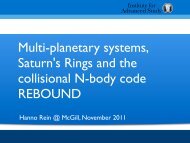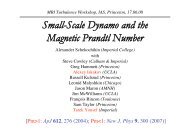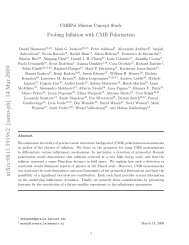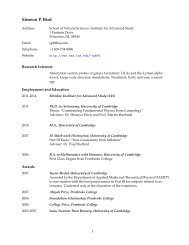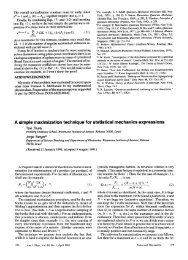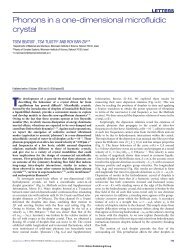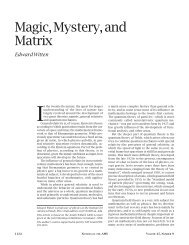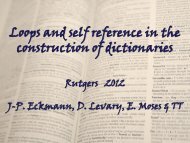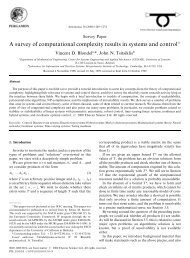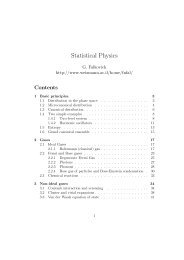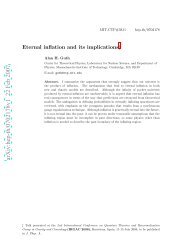Introduction to String Theory and D–Branes - School of Natural ...
Introduction to String Theory and D–Branes - School of Natural ...
Introduction to String Theory and D–Branes - School of Natural ...
You also want an ePaper? Increase the reach of your titles
YUMPU automatically turns print PDFs into web optimized ePapers that Google loves.
Therefore we have<br />
from which we can derive<br />
<strong>and</strong> so substituting in<strong>to</strong> S, we recover the Nambu–Go<strong>to</strong> action, So.<br />
Let us note some <strong>of</strong> the symmetries <strong>of</strong> the action:<br />
• Spacetime Lorentz/Poincaré:<br />
hab − 1<br />
2 γabγ cd hcd = 0 , (14)<br />
γ ab hab = 2(−h) 1/2 (−γ) −1/2 , (15)<br />
X µ → X ′µ = Λ µ νX ν + A µ ,<br />
where Λ is an SO(1, D − 1) Lorentz matrix <strong>and</strong> A µ is an arbitrary constant D–vec<strong>to</strong>r. Just as before<br />
this is a trivial global symmetry <strong>of</strong> S (<strong>and</strong> also So), following from the fact that we wrote them in<br />
covariant form.<br />
• Worldsheet Reparametrisations:<br />
δX µ = ζ a ∂aX µ<br />
δγ ab = ζ c ∂cγ ab − ∂cζ a γ cb − ∂cζ b γ ac , (16)<br />
for two parameters ζ a (τ, σ). This is a non–trivial local or “gauge” symmetry <strong>of</strong> S. This is a large extra<br />
symmetry on the world–sheet <strong>of</strong> which we will make great use.<br />
• Weyl invariance:<br />
γab → γ ′ ab = e2ω γab , (17)<br />
specified by a function ω(τ, σ). This ability <strong>to</strong> do local rescalings <strong>of</strong> the metric results from the fact<br />
that we did not have <strong>to</strong> choose an overall scale when we chose γ ab <strong>to</strong> rewrite So in terms <strong>of</strong> S. This<br />
can be seen especially if we rewrite the relation (15) as (−h) −1/2 hab = (−γ) −1/2 γab.<br />
We note here for future use that there are just as many parameters needed <strong>to</strong> specify the local symmetries<br />
(three) as there are independent components <strong>of</strong> the world-sheet metric. This is very useful, as we shall see.<br />
2.2 <strong>String</strong> Equations <strong>of</strong> Motion<br />
We can get equations <strong>of</strong> motion for the string by varying our action (11) with respect <strong>to</strong> the X µ :<br />
1<br />
δS =<br />
2πα ′<br />
<br />
d 2 <br />
σ ∂a (−γ) 1/2 γ ab <br />
∂bXµ δX µ<br />
− 1<br />
2πα ′<br />
<br />
dτ (−γ) 1/2 ∂σXµδX µ<br />
<br />
<br />
σ=π<br />
, (18)<br />
σ=0<br />
which results in the equations <strong>of</strong> motion:<br />
<br />
(−γ) 1/2 γ ab ∂bX µ<br />
≡ (−γ) 1/2 ∇ 2 X µ = 0 , (19)<br />
with either:<br />
or:<br />
∂a<br />
X ′µ (τ, 0) = 0<br />
X ′µ <br />
(τ, π) = 0<br />
X ′µ (τ, 0) = X ′µ (τ, π)<br />
X µ (τ, 0) = X µ <br />
(τ, π)<br />
γab(τ, 0) = γab(τ, π)<br />
Open <strong>String</strong><br />
(Neumann b.c.’s)<br />
Closed <strong>String</strong><br />
(periodic b.c.’s)<br />
We shall study the equation <strong>of</strong> motion (19) <strong>and</strong> the accompanying boundary conditions a lot later. We are<br />
going <strong>to</strong> look at the st<strong>and</strong>ard Neumann boundary conditions mostly, <strong>and</strong> then consider the case <strong>of</strong> Dirichlet<br />
conditions later, when we uncover D–branes, using T–duality. Notice that we have taken the liberty <strong>of</strong><br />
introducing closed strings by imposing periodicity.<br />
8<br />
(20)<br />
(21)



